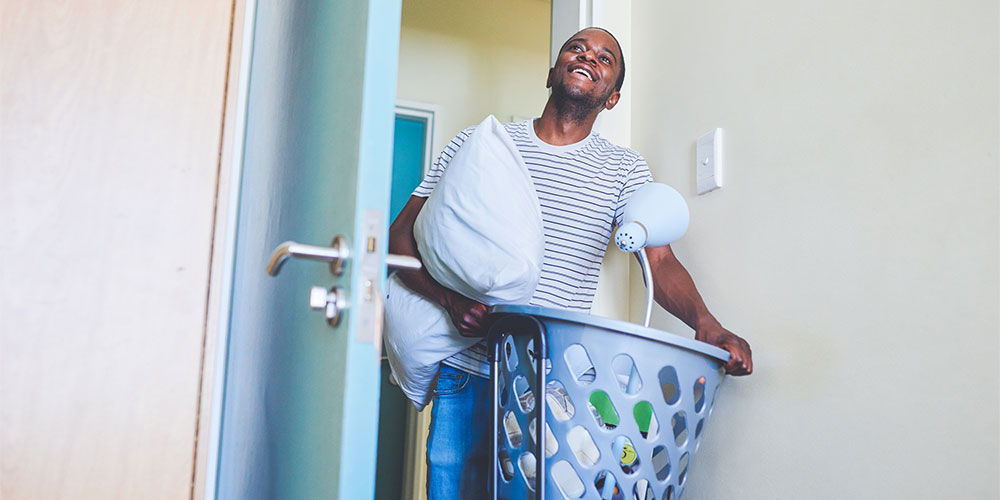Cooking is not a skill we’re born with. Eating Subway in your dorm every night is not good for your health or budget, and no amount of wishful thinking will summon your mother to do your laundry for you once you’ve moved out.
The long-outdated term “home economics” encompasses much more than these stereotypical domestic concerns. According to the American Association of Family and Consumer Sciences, “Family and consumer sciences [FACS] is the comprehensive body of skills, research, and knowledge that helps people make informed decisions about their well-being, relationships, and resources to achieve optimal quality of life.”
When venturing off to college, students need more than academic abilities. They need to know how to manage their home, their time, their money, their health, and more. Teaching students FACS skills will set them up for success in these areas and more.
The Seven Pillars of Family and Consumer Sciences
Gone are the days of family and consumer sciences being classified as “women’s work.” In fact, the discipline started as a quasi-progressive measure to help women break into other fields. According to the Observatory of Educational Innovation:
The first home economics classes incorporated various scientific disciplines as it sought to professionalize women’s work and make it more effective in freeing them from their household chores. They sought to give women time to do more things beyond just cooking and cleaning, like focusing on their education. The domestic economy was conceived to enable more women to attend college as they were taught to take care of their home and family more suitably.
With this in mind, FACS can be better thought of as the skills your students need to run their lives efficiently and effectively, in order to free up their time and energy for pursuits like work, education, and family and community life. Here are the seven essential domains of home economics, as defined by the pioneers of the field, Catherine Beecher and Ellen Swallow Richards.

Cooking: The stereotypical college meal consists of either ramen noodles or a Taco Bell burrito. Not everyone has to be Julia Child, but it is definitely advantageous for students to know how to make something nutritious. Essential cooking knowledge includes not only how to make a balanced meal, but also important lessons in food storage and safety. Yes, expiration dates matter, and no, you don’t want to store that can of bug spray next to your oatmeal.
Knowing how to cook will not only help students treat their bodies (and their wallets) well, but also can help them socially. In many cultures, eating is an inherently social activity, so FACS emphasizes the ability to both feed your own family and host meals for large groups (say, a whole floor of a college dorm).
Classroom Activity Idea
Give your students a common college scenario: They’re sophomores and living off-campus for the first time. Their apartment has a fully equipped kitchen but empty cabinets, and they’re too broke to eat out. Have them create a meal plan and grocery list to feed themselves for one week. Bonus points if they include considerations such as a budget, the food’s nutritional value, and the amount of time it will take them to prepare each meal (an important consideration when you’re juggling a full course load).

Child Development: Most college-bound students don’t have children of their own, and might not for several years. However, knowing about child development has benefits far beyond raising your own children. Some college students might be pursuing careers that involve working with or providing services for children, and many more interact with children in their daily lives, whether through babysitting, visiting with nieces and nephews, or being part of religious communities.
In this area of FACS for high school students, you might not go into the nitty-gritty details about how to care for an infant or how to educate a preschooler. However, knowing some of the basics of childhood development will help your students understand how children see the world at each stage. This knowledge will help them communicate better and have richer relationships with the children in their lives.
Classroom Activity Idea
Partner with an elementary school teacher near you to match your high school students with elementary school “buddies.” Once a month, have your students read to their younger buddies, go on a nature walk together, or complete a craft project. Your students will see child development in action, plus they’ll see how they can be a good mentor and influence in younger people’s lives!

Education and Community Awareness: In the FACS world, this principle doesn’t necessarily center around receiving an education and becoming a good citizen yourself (although that’s important too). Rather, traditional home economics sought to ensure that you could teach others both academic subjects and citizenship skills, including moral and ethical lessons. In fact, according to Kristyn Hammond, the study of elementary education has its roots in home economics programs.
The ability to teach others is a skill every incoming college student will be able to use. Whether it’s helping group members on projects or working with colleagues in the future, your students will benefit from understanding how to communicate new ideas and instructions to others.
Classroom Activity Idea
Either allow your students to choose or assign them an issue related to civics. Examples might be how to vote, how to contact your local representative, how to organize a service project, how to start a recycling program, etc. Either individually or in groups, students should research their topic and then craft a lesson to teach the rest of the class how to perform this aspect of being a good citizen.

Home Management and Design: This area of FACS encompasses everything from simple skills such as how to keep a home clean and organized to higher order endeavors such as interior design and decoration. Your students might not need to compete for the cover of Best Dorm Rooms USA, but knowing how to keep their space tidy and sanitary will set them up for success in many ways.
For example, college students often live in tight spaces and are juggling multiple courses and responsibilities at once. Having an organization system and cleaning routine will help them minimize distractions so they can focus on studying (instead of looking for lost objects or realizing they’re out of clean clothes moments before class starts).
Classroom Activity Idea
For many students, the first place they live on their own will be much smaller than their parents’ house. Challenge your students to build a model of what their new space might look like using a 3D design software such as SketchUp. Have your students list out all the essentials they’ll need for college life and see how those things might fit in a dorm room or apartment. Doing so will quickly impress upon your students the need to stay organized!

Sewing and Textiles: Making clothes used to be a full-time endeavor. A woman might spend hours of each day spinning yard, weaving fabric, creating patterns, and sewing cloth to make garments for her family. The process was so arduous, in fact, that the textile industry is much of what spurred the innovations of the Industrial Revolution.
Thankfully, we’ve come a long, long way from those days, and the most that a typical American needs to know about textiles is how to mend a tear or sew a hem. Still, sewing is a highly useful skill that every college student should know. It will help them lengthen the lifespan of their clothing, saving them money and preventing waste.
Classroom Activity Idea
Check out these 25 free sewing projects for kids compiled by Jacquelynne Steves. Whether it’s a toothbrush travel case, a fabric bookmark, or a glove monster, these simple projects will give students a taste of basic stitches and leave them with a fun keepsake at the end!

Budgeting and Economics: Budgeting is perhaps the most important pillar of interpersonal success in college, as most every student lives on a tight budget. We often hear about young people who make mistakes with credit cards, overdraw their accounts, or go without basic necessities due to budgeting mistakes or misunderstandings. And as a broader economic issue, students often take out large school loans that may dictate their finances for the next 10 or more years.
The sooner your students learn how to budget, the better they’ll be able to handle the financial challenges of college, and the more successful they’ll be when they start earning a full-time income.
Classroom Activity Idea
Check out this list of free financial literacy games for high schoolers, from Edutopia. For example, Payback helps students understand how they can minimize student loan debt, Money Magic uses storytelling and gamification to teach budgeting basics, and STAX teaches students about the power of investing for the future.

Health and Hygiene: Hopefully (for your sake), your high schoolers have learned personal hygiene by now. But when they forge out on their own, they need to know much more about health and hygiene. Good hygiene often promotes better health outcomes. For example, it’s important for students to keep their clothing, linens, and dorm clean so they don’t attract bugs or mold that can make them sick. Handwashing and other basic sanitation practices will also help combat germ spread at parties and other high-traffic events.
Even with excellent hygiene, students will inevitably deal with sickness, and they need to know how to take care of themselves, their roommates, and later on, family members as well. Students should understand how to remedy clogged sinuses, monitor a fever, treat cuts, take over-the-counter drugs responsibly, and seek health care when necessary.
Classroom Activity Idea
Navigating today’s health care system can be overwhelming even for adults, and once you get in front of a doctor, it’s easy to get tongue-tied or forget what questions you wanted to ask. To help your students prepare for solo medical care appointments, share this lesson on talking with your doctor, from Scholastic.






